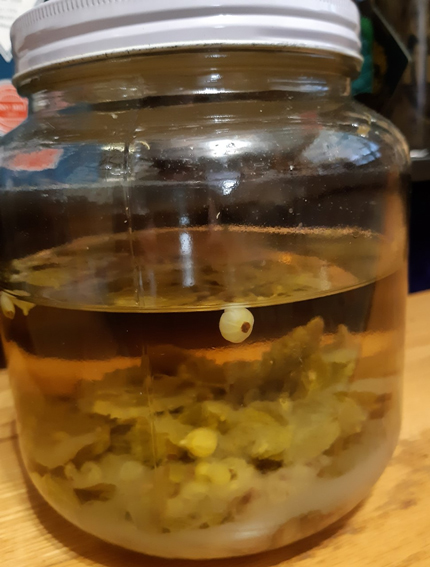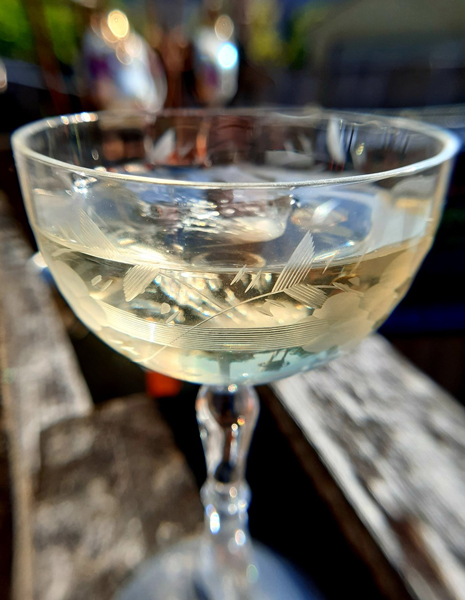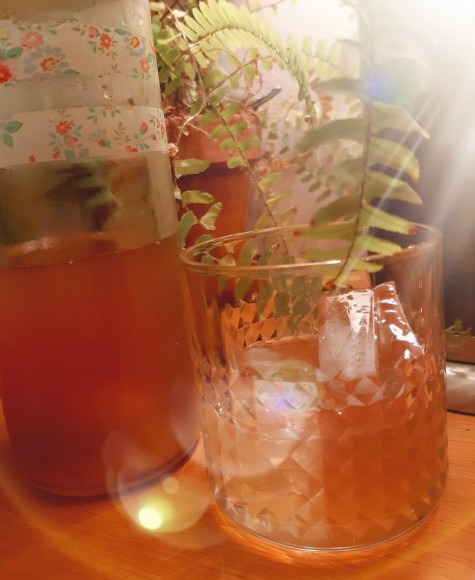August 27, 2021
It’s funny (to me, if no-one else) to have a very tough drink name like “Fugger’s Revenge” for a light-bodied, friendly, vermouthy (in a way, though I’m not calling this vermouth, cause I don’t want the vermouth board after me), aperitif-style sipper (the aperitif board is much less ferocious). But the backstory really is not so tough, but is one of my fav wine stories (one that some people say isn’t true, is just apocryphal, etc. Some people are also fuddy-duddies and no fun to have a drink with. Avoid them). Anyway, it starts early in the year 1111. A forward-thinking German bishop named Johann Fugger was getting ready to travel to Rome for the Holy Roman Emperor’s coronation (this one was Henry V). Because he was forward-thinking, Fugger sent his assistant along the road first, to scope out the local wine, chalking the pubs or bars or 12th-century what-have-yous that had good wine with the word “est,” which is Latin for “there is” (the full phrase he kept in his wine journal was I believe “vinum est bonum” or “wine is good” basically). When this intrepid wine scout came into the town of Montefiascone, he so enjoyed the wines that he A: had a lot, and B: wrote Est! Est!! Est!!! on the bar’s outside wall to show his enthusiasm. I believe bishop Fugger himself liked these particular wines so well he never made it to the coronation, just stayed in Montefiascone drinking wine, and is buried there today. And, the white wines designated Est! Est!! Est!!! di Montefiascone are still made and enjoyed. And (here’s where it also comes back around), this particular homemade aperitif uses an Est! Est!! Est!!! di Montefiascone wine as it’s base! Neat! Awesome! Story!

There aren’t a wide range of these whites available here, but Pietro Est! Est!! Est!!! tends to be available, and it’s what I used. Light, apple-y, dry, and very refreshing, it provided the perfect platform for building this summertime aperitif (and it won’t set you back too much). The other flavorings almost all came from my yard, including white currants (want to know way more about my white currant bush? Check out the Currant Current liqueur, Strawcurranterry, a white currant strawberry liqueur, and A Particular Friend, a white currant mint number), fresh mint, and fresh marjoram. A little gentian root because life is bitter (but not, one hopes too bitter most days), a little vodka to im-proof things a bit (but not too much, as this is a very light-on-its-feet charmer), and a little simple syrup to round our edges without making it sweet. Altogether, this late summer aperitif rises to the level of the wine story with delicate herbal and fruit notes. Pretty swell on its own, chilled or over ice, but also a pleasant pal in cocktails (heck, though it is not a vermouth, it would make a mean Martini-esque drink when paired with a London-style gin).

Fugger’s Revenge
1/2 cup white currants
1/3 cup fresh mint
1/4 teaspoon gentian root
1 Tablespoon marjoram
1 750 ml bottle Pietro Est! Est!! Est!! white wine
1 cup vodka
1/2 cup simple syrup
1. Add the currants, mint, gentian, and marjoram to a large glass jar with a good lid. Muddle well, but not wackily (you do want to break up the currants as much as possible).
2. Add the wine and vodka, and stir. Put in a cool dry place and let sit for two weeks, swirling regularly.
3. Open up the jar of joy and add the simple syrup. Stir again, and re-place in that cool dry place. Let sit two more weeks, swirling as you will.
4. Strain – I like to strain once through a fine mesh strainer, then twice (or as needed) through cheesecloth – into a good glass bottle. Store in the fridge (to keep nice and chilled).
Tags: aperitif, Chase Smoke flavored vodka, cocktail, Cocktail Recipes, Est! Est!! Est!!, Friday Night Cocktail, Fugger’s Revenge, gentian, homemade aperitif, Italy, marjoram, Mint, Pietro Est! Est!! Est!! white wine, What I’m Drinking, white currants, white wine aperitif, Wine
Posted in: aperitif, Cocktail Recipes, Italy, Recipes, vodka, What I'm Drinking, Wine
October 2, 2020
Here’s a fine kettle of various ingredients mixed with booze. I had the mad/smart/odd/random/bored/inventive/normal idea not more than a couple weeks ago that I should make up a wine-based liqueur or aperitivo if you like (I like, so I’m gonna call it that), and that it should have basil in it (cause my basil plants were doing so well then, if, admittedly, not as well now as summer has dwindled), and maybe orange (cause I had an orange), and a roasted peach (which also was around and needed to be used, sans pit, but the roasting felt important), and some spices but not too many, and a hint of bitterness cause the best aperitivos (or many of them) tend to have that, and it should be pretty as that hour on a sunny late-summer day when night is nearly there, but not quite there, the hour you realize once again that summer and all things are transient, ephemeral, lovely. Whew, seems like a lot to ask of something made in a big glass jar!
But, you know, it worked out quite well. Not sure I reached the full heights I wanted, but came close-ish, to my taste, which might be different than yours. The basil is the strangest part of the equation, as it lost some of its, well, basil-ness if that makes sense. There’s not overriding basil smell or taste, or any, or very little; instead, it adds a slightly vegetal minty-ness. Interesting! The orange notes come through strong, with a little other citrus (thanks to lemon) and a dream of toasty peach, and the spice notes (tiny bits of ginger, star anise) are more inferred than active, if that makes sense. Oh, I should have started with: the wine I used as the base was an Orvieto Classico white wine, which I love, and which is dry-ish, but fruit-y-ish (more peach notes here), and grape-ish enough to bring a lot of flavor. I also added some vodka, as the wine solo didn’t seem to have enough umph for the end-of-summer delicate sadness I wanted. Sure, I’m weird! Gentian, the bittering agent of choice for so many things, underlines that thought, as well as balancing the sweetness. Really, all joshing and flighty language aside, Caducitivo (caduco in Italian meaning transient or ephemeral) was an awfully fun, and tasty, experiment, a fine pre-dinner, sipper, with a layered, light, orange-citrus-herb flavor containing a friendly bitter back end. Heck, I think I’ll make it again next year! And, with the below recipe, you can try it, too. I like sipping it at room temp, but think it’s best over ice, or chilled a bit. While I haven’t tried it yet, my guess is it’d be great with Prosecco, and also as a cocktail ingredient.
 Caducitivo
Caducitivo
2 cups basil
1 roasted peach (see Note)
1 whole star anise
1/2 teaspoon ground ginger
3 wide orange twists
2 wide lemon twists
2-1/2 cups Orvieto Classico (I used Ruffino, which is nice, solid, and not overly pricey)
1/2 cup vodka (I used Prairie Organic vodka, which is swell and came in the mail)
1 cup simple syrup
1/4 teaspoon crushed gentian
1. Add the basil, peach, star anise, ginger, and citrus twists to a large glass container with a good lid. Muddle nicely. Add the wine and vodka, stir, and put that lid on it. Store in a cool dark place away from the sun. Let sit two weeks, swirling occasionally.
2. Open it back up, add the simple syrup and gentian (see Second Note), and stir well. Place it back in the cool dark place, and let sit two more weeks, swirling occasionally.
3. Strain – I went once through a decent fine strainer to get the fruit out, and then through cheesecloth to add more clarity. You might need a third straining, too.
A Note: For the peach, I just baked it at 425 F until it was slightly roasted, not charred. Also, I didn’t use the pit, just the peach itself.
A Second Note: You could add this in Step 1, but I had unexpectedly ran out, so couldn’t. And there’s something (probably nothing) in adding that bittering agent later, letting the other ingredients meet up first.
Tags: aperitivo, basil, Caducitivo, cocktail, Cocktail Recipes, Friday Night Cocktail, gentian, ginger, homemade aperitif, homemade liqueur, lemon, orange, Orvieto Classico, peach, Prairie Organic vodka, simple syrup, star anise, vodka, What I’m Drinking, white wine
Posted in: aperitif, Cocktail Recipes, Italy, Liqueurs, Recipes, vodka, What I'm Drinking, Wine
























